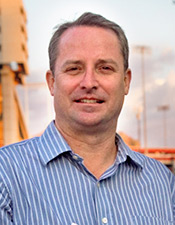A Thought Leader Series Piece
By Mick Dalrymple
Note: Mick Dalrymple is a LEED-accredited professional and co-founder of the Arizona Chapter of the U.S. Green Building Council. He is the ASU project manager of Energize Phoenix, an initiative that aims to save energy, create jobs, and improve local neighborhoods along a 10-mile stretch of Phoenix's light rail. Recently, Dalrymple has been promoting the Global Institute of Sustainability's 2013 Energy Efficiency Idea Guide for Arizona.
Imagine what would happen if an array of stakeholders made a concerted effort to cool the overnight low temperature of downtown Phoenix by one degree. For starters, more people would spend their evenings outdoors, increased economic activity would boost local businesses and tourism dollars, and roughly 21 million kilowatt hours (nearly $2.1 million) of energy would be saved per year.
But most importantly, Phoenix would become a real example to the world that we all can work together to positively change our climate.
Such is the power of One Degree, a simple concept that describes a tremendously complex and ambitious (but doable) challenge to create concerted change that improves community sustainability.
The problem
Phoenix, the sixth largest city in the U.S., is hot and getting hotter. Most climate models predict that Arizona will become drier and experience higher temperatures as climate change sets in. In downtown Phoenix, heat is absorbed and retained in our built environment, only to be re-radiated slowly at night, causing what scientists call an "urban heat island."
The general measure of the urban heat island effect is an increase in the overnight low temperature. A 2002 Arizona State University (ASU) study found that the overnight low temperature at Sky Harbor airport was 17-23 degrees Fahrenheit hotter than surrounding rural areas. This creates negative impacts on energy use, comfort, health, plants, animals, water use, equipment wear and tear, and even social justice, as elderly, poor, Hispanic, and homeless populations are disproportionately impacted.
We can improve the situation by modifying the design of our built environment, creating a counter force to the hotter temperatures.
The goal
By applying ASU's urban heat island and sustainability research, One Degree can galvanize efforts led by the local government, non-governmental organizations, and utilities to create a more livable and resilient local community in Phoenix. The broader, psychological goal is to set an example to the community and to the world that tackling climate change is possible.

We can mitigate urban heat island causes with a portfolio of known actions to physically reduce the annual average overnight low temperature, setting an initial goal of one degree within a time period of five years—enough time to develop a plan, change policies, and implement actions.
Looking to other cities, Chicago has become the "Green Roof Capital" of the United States and has at least 359 now in place. New York City is currently experiencing significant demand and operations shifts in its real estate market through the city's Greener, Greater Cities Plan that mandates public disclosure of building energy performance. Boston is the latest city to implement a similar mandate, joining Philadelphia, Seattle, San Francisco, Austin, and Washington, D.C. And since 2003, Sacramento has required that 50 percent of parking lots must be shaded by trees. Phoenix can develop key policies to create physical and behavioral change at such scale.
Possible strategies include cool roof ordinances, incentives to use the existing Green Construction Code, and promoting local sourcing and financing. There are many plans and programs already established that could be leveraged through One Degree: Phoenix Tree and Shade Master Plan, utility tree-planting programs, MyPlan Phoenix, Reinvent Phoenix, the Downtown Urban Form Project, and the Sustainable Communities Collaborative.
There are several physical strategies that could be implemented in City of Phoenix operations and promoted in the private sector. To reflect daytime heat, streets and parking lots can be refinished with heat-reflective coatings. Native and low-water trees can shade hard surfaces and cool the surrounding air. Man-made structures can do double duty as shade and solar electricity generators. Vertical parking structures can replace vast expanses of heat-absorbing parking lots. With ASU's assistance and by engaging the private sector and community groups, the possibilities abound.
The outcomes
One Degree is, from an implementation standpoint, an incredibly complex proposition. It involves coordinating many departments within city government, collaborating with many partners with often-divergent goals and management structures, identifying new funding mechanisms, and concerted change.
However, examples and many of the necessary elements exist. City of Phoenix, APS, and ASU successfully structured a complex partnership to create Energize Phoenix. The downtown Phoenix grassroots community is very active and has pulled together many successful wins including Feast on the Street, the arts scene, bicycling improvements, and the burgeoning food truck and local food movements. These examples show that with a common goal, we can come together to organize and implement change.
Even if One Degree's ultimate temperature goal is not reached, the steps taken to get there will still positively impact the livability of the city, reduce energy bills, and provide institutions additional experience with large-scale partnerships to tackle sustainability challenges. Just think of the possibilities if the One Degree goal is a serious underestimate of what is actually achievable. Phoenix owes itself the leadership opportunity to find out.
About the author: In addition to his work in sustainability, Mick Dalrymple is also a film producer having developed various green building documentaries and educational videos. He has served as director on the U.S. Green Building Council’s National Board; co-founded the Scottsdale-based a.k.a. Green Environmental Building Center; and founded the Scottsdale Green Drinks community. Dalrymple continues to remodel his 1975 home to improve its waste, water, and energy efficiency.
